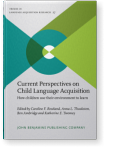Part of
Current Perspectives on Child Language Acquisition: How children use their environment to learnEdited by Caroline F. Rowland, Anna L. Theakston, Ben Ambridge and Katherine E. Twomey
[Trends in Language Acquisition Research 27] 2020
► pp. 1–7
